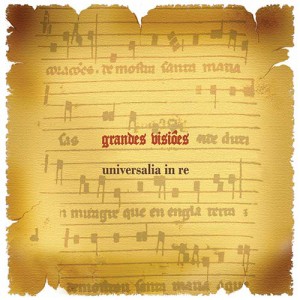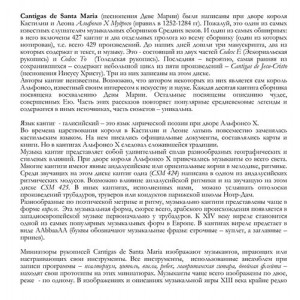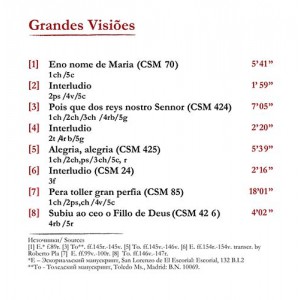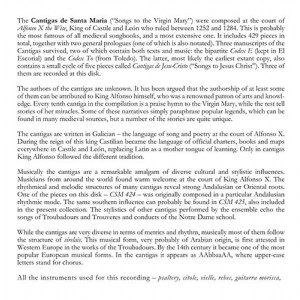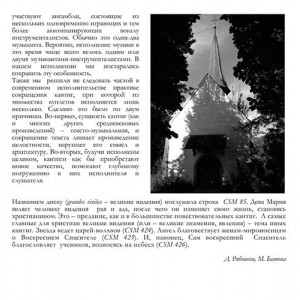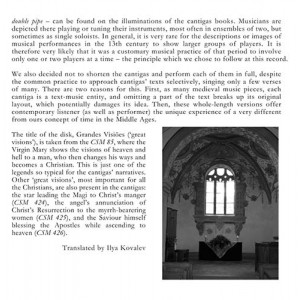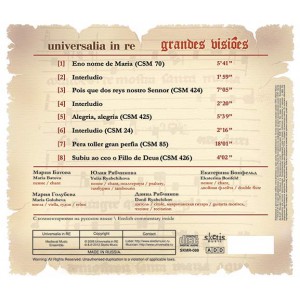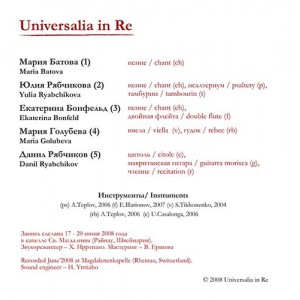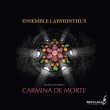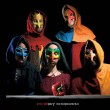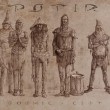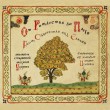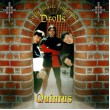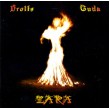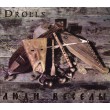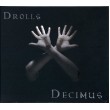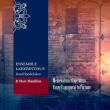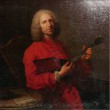Ensemble Labyrinthus - Universalia in Re - Cantigas de Santa Maria: Grandes Visiões (2011)
Medieval music ensemble "Universalia in Re" was founded in 2001 with a view to revive a medieval attitude to music as an internal experience capable to change a man. This aim determinates unusual instrumental stuff of the ensemble as well as its repertoire (mostly European music of XIII-XIV centuries).
Together with careful study of musical treatises and analysis of medieval European manuscripts, which keep traces of a unique minstrel culture, the ensemble pays a significant attention to living verbal professional musical traditions of Central Asia and Middle East
The ensemble members participated in workshops of leading medieval music teachers and musicians. The ensemble made concerts in Russia,Ukraine, Switzerland, Estonia, Poland and took part in international early music festivals in Lviv (Lviv Early Music Festival, Ukraine, 2002), Tartu (VI Tartu Early Music Festival, Tartu, Estonia, 2003) and Nizhniy Novgorod (Russia, International Machaut Festival, 2004, EARLYMUSIC, 2005)
The Cantigas de Santa Maria (“Songs to the Virgin Mary”) were composed at the court of Alfonso X the Wise, King of Castile and León who ruled between 1252 and 1284. This is probably the most famous of all medieval songbooks, and a most extensive one. It includes 429 pieces in total, together with two general prologues (one of which is also notated). Three manuscripts of the Cantigas survived, two of which contain both texts and music: the bipartite Codex E (kept in El Escorial) and the Codex To (from Toledo). The latter, most likely the earliest extant copy, also contains a small cycle of five pieces called Cantigas de Jesu-Cristo (“Songs to Jesús Christ”). Three of them are recorded at this disk.
The authors of the cantigas are unknown. It has been argued that the authorship of at least some of them can be attributed to King Alfonso himself, who was a renowned patrón of arts and knowl- edge. Every tenth cantiga in the compilation is a praise hymn to the Virgin Mary, while the rest tell stories of her miracles. Some of these narratives simply paraphrase popular legends, which can be found in many medieval sources, but a number of the stories are quite unique.
The cantigas are written in Galician — the language of song and poetry at the court of Alfonso X. During the reign of this king Castilian became the language of offlcial charters, books and maps everywhere in Castile and León, replacing Latín as a mother tongue of learning. Only in cantigas King Alfonso followed the different tradition.
Musically the cantigas are a remarkable amalgam of diverse cultural and stylistic influences. Musicians from around the world found warm welcome at the court of King Alfonso X. The rhythmical and melodic structures of many cantigas reveal strong Andalusian or Oriental roots. One of the pieces on this disk — CSM 424 — was originally composed in a particular Andalusian rhythmic mode. The same Southern influence can probably be found in CSM 425, also included in the present collection. The stylistics of other cantigas performed by the ensemble echo the songs of Troubadours and Trouveres and conducís of the Notre Dame school.
While the cantigas are very diverse in terms of metrics and rhythm, musically most of them follow the structure of virelais. This musical form, very probably of Arabian origin, is first attested in Western Europe in the works of the Troubadours. By the 14th century it became one of the most popular European musical forms. In the cantigas it appears as AAbbaaAA, where upper-case letters stand for chorus.
All the instruments used for this recording — psaltery, citóle, vielle, rebec, guitarra morisca, double pipe — can be found on the illuminations of the cantigas books. Musicians are depicted there playing or tuning their instruments, most often in ensembles of two, but sometimes as single soloists. In general, it is very rare for the descriptions or images of musical performances in the 13th century to show larger groups of players. It is therefore very likely that it was a customary musical practice of that period to involve only one or two players at a time — the principie which we chose to follow at this record.
We also decided not to shorten the cantigas and perform each of them in full, despite the common practice to approach cantigas’ texts selectively, singing only a few verses of many. There are two reasons for this. First, as many medieval music pieces, each cantiga is a text-music entity, and omitting a part of the text breaks up its original layout, which potentially damages its idea. Then, these whole-length versions offer contemporary listener (as well as performer) the unique experience of a very different from ours concept of time in the Middle Ages.
The title of the disk, Grandes Visióes (‘great visions’), is taken from the CSM 85, where the Virgin Mary shows the visions of heaven and hell to a man, who then changes his ways and becomes a Christian. This is just one of the legends so typical for the cantigas’ narratives.
Other ‘great visions’, most important for all the Christians, are also present in the cantigas: the star leading the Magi to Christ’s manger (CSM 424), the angel’s annunciation of Christ’s Resurrection to the myrrh-bearering women (CSM 425), and the Saviour himself blessing the Apostles while ascending to heaven (CSM 426).
Credits:
Maria Batova - chant
Yulia Ryabchikova - chant, psaltery, tambourin
Ekaterina Bonfeld - chant, double flute
Maria Golubeva - viella, rebec
Danil Ryabchikov - citole, guitarra morisca, recitation
On the site of our store, you can buy album Universalia in Re - Cantigas de Santa Maria: Grandes Visiões, as well as other albums of the label Sketis Music with ethnic and Medieval music of Russia, as well as free to listen and find links to legally download this and over albums.
1. Eno nome de Maria (CSM 70)
2. Interludio
3. Pois que dos reys nostro Sennor (CSM 424)
4. Interludio
5. Alegria, alegria (CSM 425)
6. Interludio (CSM 24)
7. Pera toller gran perfia (CSM 85)
8. Subio ao ceo o Fillo de Deus (CSM 426)
1. Eno nome de Maria (CSM 70)
Esta e' de loor de Santa Maria, das cinque que a'no seu nome e o que queren dizer.
Eno nome de Maria cinque letras, no-mais,y a.
1. M mostra MADR' e MAYOR
e mais MANSA e mui MELLOR
de quant' al fez Nostro Sennor
nen que fazer poderia.
2. A demostra AVOGADA,
APOSTA e AORADA,
e AMIGA e AMADA
da mui santa conpannia.
3. R mostra RAM' e RAYZ,
e REYNN' e Emperadriz,
ROSA do mundo; e ffiz
quena vis se ben seria.
4. I nos mostra JHESU-CRISTO,
JUSTO JUYZ,e por isto
foi por ela de nos visto,
según disso Ysaya.
5. A ar diz que AVEREMOS
e que tod' ACABAREMOS
aquelo que nos queremos
de Deus, pois ela nos guia.
3. Pois que dos reys nostro Sennor (CSM 424)
Esta segunda é de como os tres Reis Magos veron a Beleen aorar a
Nostro Sennor
Jesu-Cristo e lie ofereron seus does.
Pois que dos Reys Nostro Sennor
quis de seu linage decer,
con razon lies fez est' amor
en que lies foi aparecer.
Esto foi quand' en Beleen
de Santa Maria naçeu
e a treze dias des en
aos tres Reys apare9eu,
que cada u per seu sen
ena estrela connoçeu
com' era Deus Rey; e poren
de longe o foron veer,
Ben das insoas de Sabá
e de Tarsso, que son no mar,
e d'Arabia, u gran gent' á
e muitas térras de passar.
Mas pero eran lonj' alá
mui tosté os fezo chegar
a Beleen aquel que á
sobre todas cousas poder.
Ena estrela lies mostrou
com' era om' e Rey e Deus;
poren cada u lie levou...
oferta dos tesouros seus.
E a estrela os guyou
ate ena térra dos judeus,
u Erodes lies demandou:
«Que vestes aqui fazer?»
Eles responderon-11' assi:
«Na estrela vimos que Rey
mui nobre na9era aqui,
Sennor dos judeus e da lei.»
Diss' Erodes: «Creed' a mi,
ca bon conssello vos darei:
id', e pois tomardes des i,
ar y-lo-ei eu connoçer.»
Eles foron-sse logu' enton
e virón a estrela yr
ante ssi de mui gran randon,
e come9árona seguyr;
mas quand' en Beleen foi,
non se quis de sobr' ela partir,
ata que entraron u Don
Jesu-Cristo virón seer
Nos braços da que muit' afan
sofreu con el e muito mal.
E eles logo manaman
deron-lle sa oferta tal:
ouro de que aos reis dan,
encensso por espirital,
mirra de que os mortos van
ungir por nunca podreçer.
Esto, ca non maravidis,
ofereron a Deus los Reys;
porend' assi os guardar quis
aquele que juntou as leis,
que per sonnos os fez ben fis,
que sonnaron vel cinc' ou seis
vezes que fossen a Tarssis
passa-lo mar por guacer.
5. Alegría, alegria. CSM 425
Esta terceira é como Nostro Sennor resurgiu e como se mostrou aos apostolos e aas tres Marios.
Alegria, alegria fagamos ja todavia.
Mui grand' alegria fazer
devemos, ca Deus quis morrer
por nos e a morte vençer
morrendo, que nos vençÍa.
Quen tan grand' alegria viu
com' esta? Ca nos reemiu
Deus por sa mort' e resurgiu
do sepulcr' a terçer dia.
Grand' alegria nos creçeu
quando do ceo deçendeu
o angeo, e que tremeu
a térra u el deçia.
Grand' alegria nos deu Deus
quando con pavor os judeus
do angeo, esses encreus,
cada un deles caya.
Grand' alegria, a la fe,
foi pois Maria Salome
e Jacobe con aloe
e Madalena Maria,
Mui grand' alegria nos dar
foi Deus u o foron buscar
ao móyment', e achar
niha délas podia.
[G]rand' alegria ouv' ali
enton quando lies diss' assi
o angeo «non ést' aqui
que sobr' a pedra seya.
Grand' alegria, sen mentir,
foi u lies disse: «Resurgir
quis Jeso-Crist', e se vos yr
queredes u el dizia,
Grand' alegria vos será;
ca o veeredes alá
en Galilea, u está
segund' vos el dit' avia.»
Alegria de coraron
ouveron elas; e enton
foron alá, e Simeón
Pedr' y foi, a que prazia.
Mai-la alegria mayor
foi a da Madre do Sennor,
que resurgiu, e gran sabor,
porque viu o que creya.
7. Pera toller gran perfia. CSM 85
Como Santa Maria livrou de morte un judeu que tiinnan preso hus ladroes, e ela soltó-o da prijon e feze-o tomar crischao.
Pera toller gran perfia
ben dos coraçÕes,
demostra Santa Maria
sas grandes visióes.
Onde direi un miragre que en Englaterra
demostrou Santa Maria, a que nunca erra,
por converter un judeu que prenderán ladroes,
a que chagas grandes deran e pois tozilloes.
Os ladroes que fezeron est' eran crischáos;
e poi-lo ouveron feito, ataron-11' as máos
e os pees e deron-lle muitas con bastóes,
que lies esterlis désse, ca non pipióes.
Desta guisa o teveron fora do camo
atad' en ha gran casa vella, o mesquinno;
e deron-lle pan e agua aqueles peóes,
en tal que lies non morress' e ouvessen quinnóes
Do seu aver. Mais el conas pas que sofria
adorme9eu, e en sonnos viu Santa Maria
mais fremosa que o sol; e logo 11' as prijóes
quebrantou, e foi guarido de todas lijóes.
E pois que sonnou aquesto, foi logo despertó,
ar viu-a espert' estando, de que foi ben çerto;
e por saber mais quen era, fez sas orarçÓes
que lie dissesse seu nome, e dar-ll-ia dóes.
E ela lie disse logo: «Para-mi ben mentes,
ca eu sóo a que tu e todos teus parentes a
vedes mui gran desamor en todas sazóes,
e matastes-me meu Filio come mui felóes.
E poren mostrar-te quero o ben que perdedes
e o mal que, pois morrerdes, logo averedes,
que en min e en meu Filio vossas entençÕes
tornedes e cebades boos gualardóes.»
Enton o pres pela máo e tiró-o fora
dali, e sobr' un gran monte o pos essa ora
e mostrou-lle un gran vale cho de dragóes
e d' outros diabos, negros mui mais que carvóes,
Que mais de 9en mil maneiras as almas peavan
dos judeus, que as cozian e pois ar assavan
e as fazian arder assi como tÍçoes,
e queimando-lle-las barvas e pois os grinóes.
Quand' o judeu viu aquesto, foi end' espantado;
mais tan tosté foi a outro gran monte levado
u viu seer Jesu-Cristo con religióes d' angeos,
que sempre cantan ant' el doçes sóes
E viu de muitas maneiras y santas e santos
muit' alegres, que cantavan saborosos cantos,
que rogan polos crischáos que Deus d' ocajóes
os guarde e do diab' e de sas tentaçÕes
Santa Maria lie disse, pois est' ouve visto:
«Estes son meus e de meu Filio, Deus Jesu-Cristo,
con que seras se creveres en el e leytóes
comeres e leixares a degolar cabróes.»
Pois que Santa Maria lie diss' este fazfeiro,
leixó-o; e el foi-sse log' a un móesteiro
u achou un sant' abade con seus conpannóes,
que partiron mui de grado con el sas raçÕes.
E pois que ant' o convento contou quanto vira,
o abad' o fez crischao logo sen mentira;
e deste feito foron pelas térras pregóes,
por que a Santa Maria deron ofreçÕes.
8. Subiu ao ceo o Filio de Deus. CSM 426
Esta quarta é como Nos tro Sennor subiu aos feos ante seus dicipolos.
Subiu ao ceo o Filio de Deus
por dar Parays' aos amigos seus.
Subiu ao ceo, onde quis deçer
en térra por nos e da Virgen nacer,
e depois paixon e morte quis prender
mui forte na cruz per máo dos judeus.
Onde foi assi que en Jerussalen
teve sa gran festa, como Sennor ten,
con sa conmpanna; e pois comeron ben,
trouxe-os mui mal porque eran encreus;
Porque non quiseron creer nen oyr
os que o viran de morte resurgir.
Porend' ant' eles aos ceos subir quis,
segundo conta Marcos e Mateos.
Mas ante les disse: «Ide preegar
o meu Evangeo per cada logar,
e quantos creveren e se batizar
quiseren de grado, logo serán meus.
Os que non creveren, perdudos serán;
mai-los outros os diabres deitarán
dos ornes e lenguages falarán mais
que aqueles que albergan romeus,
Nen lies nuzirá se beveren poçon,
e guarrán de todo mal e de lijon
aos enfermos.» E aqueste sermón
fez en Mont' Olivete ant' os ebreus
Pois est' ouve dito, ñas nuves subiu,
e a gent' aos ceos subi-lo viu,
que a voz dos angeos logo oyu
que lies diss' assi: «Varóes galileus,
Ena maneira que o veedes dacá
subir ao ceo, ben assi verrá
joyga-lo mund' e os mortos fará
resurgir, que non creen os fariseus.»


